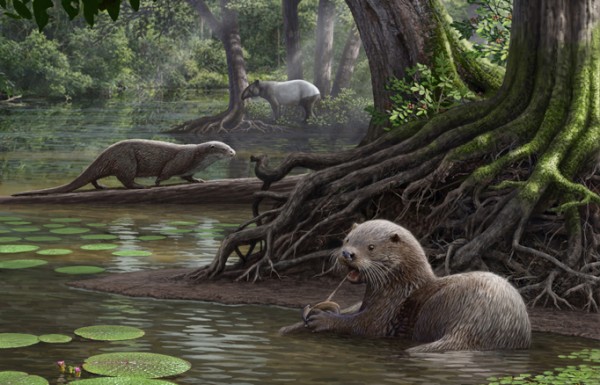By Ana Verayo, | January 24, 2017

Siamogale melilutra was about the size of a wolf and weighed approximately 110 lbs., almost twice as large as the largest living otters. (Cleveland Museum of Natural History)
Scientists have discovered a new, extinct species of giant otters in China, estimated to weigh more than 100 pounds.
Researchers have named this ancient creature Siamogale melilutra. The team chose this name since it is a combination of the Latin names of badger "mele" and otter "lutra." These giant otters used to thrive in Yunnan province, China some 6.24 million years ago.
Like Us on Facebook
The fossilized remains of this prehistoric otter were uncovered in pristine condition, along with crucial skeletal parts like the cranium, mandible, and teeth. Researchers were able to identify the lost species easily in detail and determine its taxonomy and classification, historical evolution, and functional morphology as well.
According to the co-author of the study, head of paleobotany and paleoecology, Denise Su of the Cleveland Museum of Natural History, the cranium was incredibly complete and was found flattened during the fossilization process.
"The bones were in fragile condition that we cannot physically restore the cranium, where we opted to use CT scans instead to examine the specimen, and developed the animal's digital model via computer," she said.
According to another co-author of the study, Xiamong Wang of the Natural History Museum of Los Angeles, the species possesses features that are also found in modern day otters and badgers.
Upon studying the S. melilutra closely, scientists suggest that otter teeth have evolved to crush and eat hard-shelled creatures like clams, crabs, and mussels, revealing important clues about otter evolution.
These ancient giant otters had distinct, large round cusped teeth. The researchers found out that they were not inherited from a common ancestor. Su and the team compared the S. melilutra's teeth with modern otters and discovered that these teeth are at least four times different within the greater otter lineage.
This type of evolution is known as "convergent evolution" when animals possess the same traits or features but belong to entirely different species just because they lived in similar habitats or environments.
This new study was published in the Journal of Systematic Palaeontology.
-
Use of Coronavirus Pandemic Drones Raises Privacy Concerns: Drones Spread Fear, Local Officials Say

-
Coronavirus Hampers The Delivery Of Lockheed Martin F-35 Stealth Fighters For 2020

-
Instagram Speeds Up Plans to Add Account Memorialization Feature Due to COVID-19 Deaths

-
NASA: Perseverance Plans to Bring 'Mars Rock' to Earth in 2031

-
600 Dead And 3,000 In The Hospital as Iranians Believed Drinking High-Concentrations of Alcohol Can Cure The Coronavirus

-
600 Dead And 3,000 In The Hospital as Iranians Believed Drinking High-Concentrations of Alcohol Can Cure The Coronavirus

-
COVID-19: Doctors, Nurses Use Virtual Reality to Learn New Skills in Treating Coronavirus Patients







